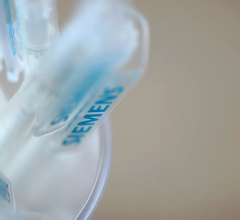
The Teleflex Manta large-bore vascular closure device can seal holes between 12 and 25 French.
While many cardiac and vascular procedures have largely moved to minimally invasive techniques, the size of these transcatheter devices has required larger arterial access introducer sheaths, leading to increases in vascular and bleeding complications. Large bore devices are generally considered anything 10 French and bigger. This growth in large bore interventions has led to a new demand for large-bore vascular closure devices.
These larger bore access devices include all the devices currently used for transcatheter aortic valve replacement (TAVR), left atrial appendage (LAA) occluders, the MitraClip device, endovascular aneurysm repair (EVAR) stent grafts, transcatheter mitral valve replacement (TMRV) devices, and hemodynamic support systems such as the Impella, TandemHeart and extracorporeal membrane oxygenation (ECMO).
"It's a growing need and I think as more procedures are done in structural heart or hemodynamic support devices are used in patients with cardiogenic shock, there is a growing need for large arterial access closure," explained Ashish Pershad, M.D., director interventional cardiology at Chandler Regional Medical Center and Mercy Gilbert Medical Center, Dignity Health, Phoenix. "Most interventions today are now done through the wrist and done with a 6 or a 7 French atrial sheath, and frequently when we do go from the groin we use an 8 French sheath. But once you get to sizes of more than 9 French, then you are looking at large bore access. Typically you need a 14 French or larger access for TAVR devices and for left ventricular support devices. And then slightly larger than that for devices that offer full cardio-pulmonary support like ECMO or TandemHeart."
You could potentially close a 12 or a 14 French hole manually, but the amount of time and resources that will take are high enough that manual compression is not the go-to standard, Pershad said. He explained that interventional cardiologists were initially a little skeptical about closure devices because they are associated with some level of complications.
"When we look at PCI, there was never an instance where closure devices reduced complications. They increased patient comfort and reduced their time to ambulate, but never were able to eliminate complications," he said. "Vascular complications are still one of the most dreaded and feared amongst interventionists who want to take on these types of procedures, but are fearful they may not be able to manage the complications that may arise from the use of these big tubes in the groin. This ends up being one of the reasons why operators are shying away from using these large bore devices, or frankly not gaining the necessary expertise they need to offer these procedures and are denying their patients this type of care."
However, these larger-bore procedures are becoming the standard of care and many operators are rethinking the need for and the use of vascular closure devices.
"It is very critical to reduce the bleeding complications so not to compromise the efficacy of these devices," explained Philippe Genereux, M.D., co-director of the structural heart program at the Gagnon Cardiovascular Institute at Morristown Medical Center, part of Atlantic Health System.
Généreux also said bleeding complications can be very expensive, often doubling the cost of a procedure. A 2017 study he was involved in showed the median costs for bleeding complications were $48,663 to manage the patient.[1] He explained periprocedural bleeding was common among patients who undergo transcatheter interventions using large-bore catheters, and this is associated with a statistically significant increase in mortality, length of stay and cost.
Closing Large Bore Arterial Access Sites
Prior to the use of closure devices, larger access sites required a surgeon to be involved to perform a surgical cut down for vessel access and then to suture the vessel closed at the end of the procedure. However this requires deeper levels of sedation, adds to patient discomfort and is more invasive and time consuming the using closure devices. Also, there has been a large movement away from using heavy sedation to conscious sedation and use of minimally invasive techniques.
Many vascular closure devices are used off-label to seal holes larger than their FDA indication, often requiring two more more devices to seal holes larger than 10 French. A common example of this is the Abbott Perclose ProGlide suture mediated closure system that is placed at the start of the case to aid closure at the end of the procedure, and often two devices are needed to close the larger holes. Pershad said this is currently used as a the gold-standard for large bore closure.
However, he said this may change now that there is a device with an FDA indicated device specifically for larger bore access and the fact that only one device is needed, rather than two ProGlides.
The Teleflex Manta is the first dedicated large bore closure device and was cleared by the FDA in 2019. It is a post-procedure closure system. It can close access sites that range in size from 12-25 French. It uses a a bioresorbable collagen anchor inside the vessel and a bioresorbable plug that are tethered together and form a sandwich when drawn together during closure.
However, Pershad notes none of these closure devices are reimbursed, so the largest limiting factor in their use is cost. But, there is a clearly a trade-off in using these devices and enabling faster ambulation, reducing staffing resources and procedure time. For the newer generation of large-bore closure devices coming to market, Pershad said the cost of these devices might arguably be justified if they can show reduced numbers of vascular and bleeding complications, the need for a surgical cut down, or eliminate the need for a blood transfusion. However, Pershad said the complications rate with the currently used technologies is pretty low, so studies will have to show how the new devices compare to the currently used devices.
TAVR, EVAR and Impella Require Large Bore Arterial Access
TAVR has become a major use scenario for large-bore access and closure, since these transcatheter valves are now used more commonly than open heart surgical replacements of the aortic valve. There is wide expectation this will also be true in the coming years for larger bore mitral valve repair and replacement devices once they gain FDA clearance.
A few years ago TAVR required around 24 French access, but new iterations of the FDA cleared Medtronic CoreValve and Edwards Sapien valves have reduced the size of the introducer sheath needed. The first generation TAVR devices led to bleeding complication rates of more than 20 percent in the Sapien PARTNER I and CoreValve ADVANCE trials. However, these rates dropped significantly after the introduction of smaller profile versions of the these valves. The rate dropped from 24% with the original Sapien device in 2010, down to 15% with the introduction of the Sapien XT in 2012. It is even lower now with current generation devices.
The current generation of the Edwards Sapien 3 and the Medtronic CoreValve Evolut valves come in sizes requiring 14 or 16 French access. TAVR valves currently seeking FDA clearance—the Boston Scientific Acurate Neo and the Abbott Portico valves—require 18 or 19 French access.
"A 14 French device is still a 2 mm hole in a pulsatile artery, with plaque still an issue, unless you can get a handle on it using either pre-closing or post-closing, depending on what device you use," Pershad said.
Another large segment of large bore access devices is for mechanical hemodynamic support. The Abiomed Impella 2.5 requires a 13-14 French access. Impella CP 14 French, Impella 5.0 21 French, and ECMO requires even larger bore access. The PulseCath hemodynamic support system available in Europe uses a 17 French access for its 2L system, and a 21 French access for the 3L system.
EVAR self-expending stent grafts require between 18 and 24 French access. Over the past two decades, this transcatheter repair method has largely replaced open vascular surgical techniques.
Use of Ultrasound Guided Vascular Access for TAVR
Another way to reduce complications from large bore access is to use ultrasound guided access instead of fluoro-guided access. This has been demonstrated in several studies to reduce vascular and bleeding complications in smaller bore access for PCI, and recent studies have shown significant improvements as well for TAVR access.[2-6]
"This is one way to optimize vascular access and made it safer for the patient and it has become a standard of care at our institution," Généreux said.
Ultrasound guidance provides better control the puncture zone of the artery and may decrease major vascular complications and life‐threatening or major bleeding complications. This was shown in a 2020 study by Vincent, et al.,[2] which included more than 500 TAVR patients using the Sapien or CoreValve and access guide by angiography or ultrasound. All vascular and bleeding complications with the second generation TAVR devices were reduced in the ultrasound guided group compared with the fluoroscopy guided group. Vascular complications dropped 16.8% versus 6.3%; life‐threatening or major bleeding 22.1% vs. 6%; and vascular complications related to vascular access dropped 12.6% vs. 4.2%.
The study found even better results with use of the third generation TAVR devices and ultrasound‐guided access. Rates of major vascular complications were 3.2% and life‐threatening or major bleeding were 3.6%. In the overall population (n=546), life‐threatening or major bleeding was associated with a 1.7‐fold increased mortality risk (P=0.02).
However, there is speculation that these types of improvements in complications may actually be due to operators gaining more experience and using smaller profile devices, rather than ultrasound being the key.[7] Also, another 2020 study comparing ultrasound and fluoro guided access found no difference between the techniques.[8]
Monitoring and Early Detection of Vascular Closure Complications
Despite best efforts to close a large bore access site, bleeding sometimes occurs and the key to managing bleeding complications is to catch it early and intervene. "There is a need for monitoring these patients and to recognize bleeding early," Généreux said.
He was involved with the clinical studies for the Saranas Early Bird monitoring system, which is the first smart introducer sheath with sensors embedded in the sheath wall to detect bleeding. "I think this technology will be able to help in monitoring patients in the recovery mode," he concluded.
The bleeding early monitoring system was cleared by the FDA in 2019.
Related Large-bore Vascular Closure Content:
VIDEO: Use of Large Bore Vascular Closure — interview with Ashish Pershad, M.D.
VIDEO: How to Achieve Hemostasis With Large Bore Device Access — Interview with Philippe Genereux, M.D.
Large-Bore Vascular Closure Device Cleared by the FDA
Manta Vascular Closure Device Safely Closes Large Bore Arterial Access Sites
Teleflex Acquires Essential Medical
PerQseal Large Bore Closure Device Launches in Europe
Use of Ultrasound to Improve Vascular Access
FDA Approves Vascade MVP Vascular Closure System for LAA Occlusion and EP procedures
First-in-Human Results Show Early Bird Device Effective in Early Detection of Internal Bleeding
Advances and Trends in Vascular Closure Devices
References:


 November 14, 2025
November 14, 2025 









